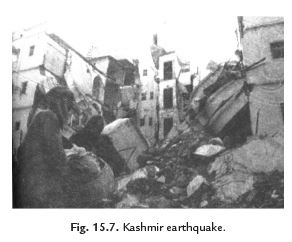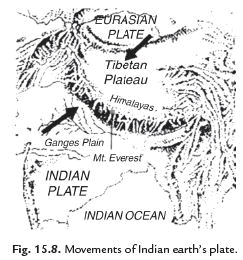Class 8 Science Chapter 12 Question Answers - Some Natural Phenomena
Q1: What are the causes of sparking?
Ans. Causes of sparking:
(i) On electric pole wires become loose.
(ii) Blowing of wind and shaking the wires.
(iii) Loosenes
Q2: What happens when amber is rubbed of fur?
Ans. When amber is rubbed with fur, it attracts light objects such as hair. In the same way woollen and polyester clothes also attract light objects.
Q3: Who established the relation between sparks produced by amber and the thunderstorms?
Ans. An American Scientist Benjamin Franklin established that sparks produced by amber are similar to those produced in sky during a thunderstorm. He flew a kite tied with a silken thread, which had an iron key attached to it on a rainy day. During lightning he felt the shock through iron key, which proved that clouds also carried charges.
Q4: How can charging take place when the substances are rubbed?
Ans. When a plastic refill is rubbed with polythene, it acquires a small electric charge. Similarly, when a plastic comb is rubbed with dry hair, it also acquires a small charge. These objects are called charged objects. In this process of charging the refill and the plastic comb, polythene and hair also get charged.
Q5: How many different types of charges are there? Write the nature of charges on glass rod and silk cloth when they are rubbed each other?
Ans. There are two types of charges:
(i) Positive charge and
(ii) Negative charge
Charge acquired by a glass rod rubbed with silk is called positive charge and the charge acquired by silk cloth is called negative charge.
Q6: What is static electricity? How is it different from electric current?
Ans. The electrical charges generated by rubbing produce static electricity. The charges do not move in static electricity while charges move in current electricity.
Q7: What is electric discharge? How does it occur?
Ans. The negative and positive charges meet, producing streaks of bright light and sound. This process is called electrical discharge, the process of electric discharge can occur between two or more clouds or between clouds and earth.
Q8: How does electric discharge occur in clouds?
Ans. At the time of thunder negative charges get accumulated near the clouds and positive charges accumulate near ground. When these charges meet electric discharge takes place between ground and clouds. In this process a large amount of energy is released as thunder and lightning.
Q9: During lightning what should we do?
Ans. (i)Hearing thunder is an alert to rush to a safer place.
(ii) After hearing the last thunder wait for some time before coming out.
Q10: What is lightning conductor? How does it protect building from lightning?
Ans. Lightning conductor is a device used to protect building from the effect of lightning. A metallic rod taller than the building is installed in the walls of the building during its construction. One end of the rod is kept out in the air and the other is buried deep in the ground. The rod provides easy route for transfer of electric charge to the ground.

Q11: What is an earthquake? How does it occur?
Ans. An earthquake is a sudden shaking or trembling of earth which lasts for a very short time. It is caused by a disturbance inside the earth’s crust. There can be a great loss to life and property. They can cause flood, tsunami and landslides. The magnitude of the earthquake is measured by an instrument called seismograph and it is measured on Richter Scale.

Q12: Write about two last major earthquakes in India.
Ans. (i) A major earthquake occurred on 26 January 2001 in Bhuj district of Gujarat.
(ii) A major earthquake also occurred in India on 8 October 2005 in Uri and Tangdhar towns of North Kashmir.
Q13: Name the regions of the earth more prone to earthquakes.
Ans. Earthquakes are caused by the movement of plates. The regions which fall on the boundaries of these plates are called danger zones. Earthquakes are most likely to happen in these danger zones.
Q14: What are fault zones? Name the fault zones in India.
Ans. The areas fall between the boundaries of two plates are called weak zones or seismic or fault zones. In india the most threatened areas are Kashmir, Western and Central Himalayas, whole of North-East, Rann of Kutch, Rajasthan, Indo-Gangetic plain and some areas of south India. Q15: What are the protections to be taken against earthquakes?
Q15: What are the protections to be taken against earthquakes?
Ans: If you are at home:
1. Take shelter under the table and stay there until the stoppage of shaking
2. Keep yourself away from the tall or heavy objects that may fall on you and damage you.
3. If you are on bed, do not get up and keep a pillow on your head
If you are outside the home:
1. Find a clear spot, away from buildings, trees, poles and electric poles, signboards and overhead power lines and drop to the ground.
2. Do not use elevators if they are available at some place outside your house
3. If you are in a car or a bus, do not come out and drive slowly to a clear spot.
Q16: What are the protections to be taken against lightning?
Ans: During lightning avoid going at an open place, try to rush towards safe place like in a house or building, if you are travelling in nay vehicle like car or bus, you are safe inside with windows and doors of the vehicle closed. If you are in a forest take shelter under a smaller tree.
Q17: Explain a lightning conductor and its function.
Ans: Lightning conductor is the device that protects a tall building from lightning strike, by providing an easier path for current to flow to earth than through the building. It consists of a thick copper strip of very low resistance connected to the ground below. A good connection to the ground is essential and is made by burying a large metal plate deep in the damp earth. In the event of a direct lightning strike, the current in the conductor may be great as to melt or even vaporize the metal, but the damage to the building will nevertheless be limited.
Q18: List the things that you should do while thunderstorm.
Ans: During lightning avoid going at an open place, try to rush towards safe place like in a house or building, if you are travelling in nay vehicle like car or bus, you are safe inside with windows and doors of the vehicle closed. If you are in a forest take shelter under a smaller tree.
Q19: List the things that you should not do while thunderstorm.
Ans: During lightning avoid going at an open place, try to rush towards safe place like in a house or building, if you are travelling in nay vehicle like car or bus, you are safe inside with windows and doors of the vehicle closed. If you are in a forest take shelter under a smaller tree.
Q20: Define the following
- Lightning
- Earthing
Ans:
- Lightning: Lightning is a natural phenomenon that has fascinated people for ages. Several people thought and researched about the cause of lightning and its process. Benjamin Franklin discovered for the first time that there is an electric discharge between clouds that produces a spark, and it is the electric spark between the clouds and the earth that appears as lightning. His famous kite experiment proved this fact. The occurrence of lightning is as follows. The formation of clouds involves friction between water particles in the atmosphere. The friction charges the particles. Among the positive and negative charges, the negative charge accumulates at the bottom of the cloud and the positive charges in its top. As the accumulation of the charge increases, the cloud will create a positive charge on the ground nearby. As the amount of charge increases, the negative charge on the cloud tends to make a path towards the ground, and it results in a narrow streak of electrical discharge, which we call lightning.
- Earthing: The process of transferring of charge from a charged object to the earth is called as earthing. For our safety, most of the electrical appliances and the mains of the house are connected to earth, so that we can be prevented from getting an electric shock.
Q21: Define the following:
- Richter scale
- Seismograph
Ans:
- Richter scale: The Richter scale is used to rate the magnitude of an earthquake that is the amount of energy it released. This is calculated using information gathered by a seismograph.
- Seismograph: Tremors or vibrations caused by the earthquakes which travel in the form of waves within the earth or along the earth's surface, are called seismic waves. Seismograph is an instrument which records these waves.
|
90 videos|296 docs|44 tests
|
FAQs on Class 8 Science Chapter 12 Question Answers - Some Natural Phenomena
| 1. What are some common examples of natural phenomena? |  |
| 2. How does lightning occur? |  |
| 3. What causes earthquakes? |  |
| 4. How are tornadoes formed? |  |
| 5. Why do volcanic eruptions happen? |  |
















